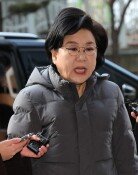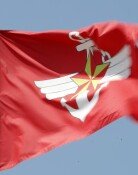Safeguards Necessary for Foreign Exchange Investments
Safeguards Necessary for Foreign Exchange Investments
Posted December. 17, 2003 22:36,
As a result of the tentatively named Korea Investment Corporation (KIC) that the government has recently announced, interest is growing in the budget limit for foreign exchange holdings, which are to be the financial resource of KIC, and their usage.
Many experts pointed out that even if the surplus of foreign exchange holdings is invested in KIC, there must be safeguards to block political meddling or excessive budget limit expansion.
How much is the reasonable limit for foreign exchange holdings?--The Ministry of Finance and Economy (MOFE) and Bank of Korea (BOK) have different views on the limit.
The Ministry of Finance and Economy has recently turned in a report to Chong Wa Dae saying, The reasonable limit for foreign exchange holdings is $121.1 billion, and going beyond this limit is advisable only for highly profitable assets.
Lee Jae-wook, vice president of BOK, refuted this by saying, There is no right answer as to the reasonable limit on foreign exchange holdings, and considering matters such as the unification of North and South Korea, we cannot say that we have much foreign exchange holdings at this moment.
Before the financial crisis, the international standard for a reasonable amount of foreign exchange holdings was three months of the countrys income.
But the International Monetary Fund (IMF) set a new standard in February 2001, saying that for countries with emerging markets, there should be at least enough foreign exchange holding to cover short-term external obligations that mature in one year or less. Also, in case of emergencies when exchange may slip overseas through the stock markets, there should be additional foreign exchange.
Korea had $61.3 billion in short-term external obligations of July, and $110.3 billion in foreign capital in the stock market. Considering the fact that no more than 20 percent of the funds running in the stock market had slipped through during the financial crisis, calculations determine that $100 billion or more should be enough in preparing external payments.
Are profit-bounded investments adequate for foreign exchange?-- BOK indicated that investing part of the foreign exchange holdings is the same as withdrawing the lease money and investing it in stocks.
In the 1980s, pushed by the Ministry of Finance at that time, $30 billion worth of foreign exchange holdings were deposited for the long-term in government-run and commercial banks, and could not be withdrawn in 1997, resulting in a foreign exchange crisis.
Byun Jae-young, manager of the international planning team of BOK, said, Foreign exchange holdings are capital that BOK made when falling into debt from issuing monetary stabilization funds, and they are not surplus capital for investment.
Choi Joong-kyung, director of the international finance bureau of MOFE, replied, If the foreign exchange is invested overseas, greater risk will arise than when BOK possess all the foreign exchange. We should keep in mind that the MOFE minister has the final authority to direct the use of foreign exchange holdings.
Lee Jang-young, senior researcher at the Korea Institute of Finance, stressed, The key concern for KIC is that foreign exchange holdings may be invested in another direction than intended or encroached upon because of pressure by the political circle. Part of the foreign exchange holdings may be used for investments at the beginning, but beyond that investments should be cut off, and a managing organization completely independent of outside forces should be created.
How should the foreign exchange holdings be used?-- As of December 15, Korea has a total of $153 billion in foreign exchange holdings, a $2.7 billion increase since the end of November ($150.3 billion). The current account surplus has increased substantially due to improved exportating, and foreign capitals have flocked to the stock market.
BOK possesses a 7 to 2 to 1 rate in dollars, euros and yen. Eighty-four percent of the foreign exchange holdings, $126.9 billion, are nominally in BOKs possession and the other 16 percent, $23.4 billion, are held as exchange equalization funds by the government.
BOK is investing 95 percent of the foreign exchange it holds into US Department of Treasury bonds and other government bonds or guaranteed bonds of major countries. There is a low interest rate of one to four percent, but it is stabilized and can be cashed in at any time.
Recently, BOK said, The profit rate of BOKs foreign exchange holding use has surpassed the standard investment profit rate, 6.14 percent, of international investment banks in 1998-2002.
But MOFE criticized, The profit rate that BOK is claiming has unrealized appreciation included in it, and if you take it out, the actual rate is on the four percent level, and in particular, the profit rate before 2000 was only one to two percent.
Joong-Hyun Park sanjuck@donga.com







